Moderate overlap front: original test
Rating applies to 2007-10 models built after January 2007
Tested vehicle: 2007 Ford Fusion SE 4-door
The Ford Fusion, Mercury Milan, and Lincoln Zephyr were introduced in the 2006 model year. The Zephyr was renamed the MKZ beginning with 2007 models. All three cars were restyled beginning with the 2010 model year, and the Mercury Milan was discontinued after the 2010 model year.
Beginning with 2007 models manufactured after January 2007, structural reinforcements were added to the floor ahead of the front seats, and the hard plastic "ramp" bolted underneath the carpeting near the base of the accelerator pedal was modified to improve occupant protection in frontal offset crashes. In addition, the standard side airbags were changed so that they would deploy in severe frontal offset crashes. (Note: information about when a specific vehicle was manufactured is on the certification label typically affixed to the car on or near the driver door.)
The tested car was manufactured after all modifications had been made.
| Evaluation criteria | Rating |
|---|---|
| Overall evaluation | |
| Structure and safety cage | |
| Driver injury measures | |
| Head/neck | |
| Chest | |
| Leg/foot, left | |
| Leg/foot, right | |
| Driver restraints and dummy kinematics | |

Action shot taken during the frontal offset crash test.

The dummy's position in relation to the steering wheel and instrument panel after the crash test indicates that the driver's survival space was maintained well.
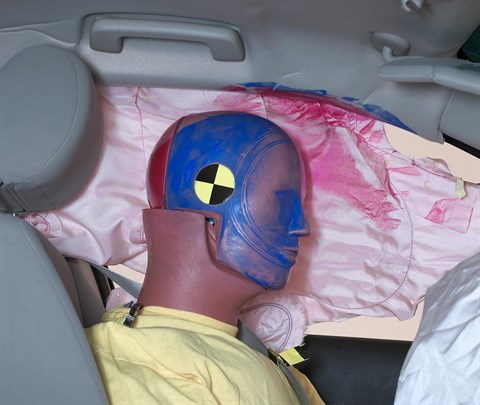
Smeared greasepaint indicates where the dummy's head brushed across the side curtain airbag and hit the roof rail during rebound, producing high forces on the neck.

Postcrash photo with carpeting removed indicating the modified "ramp" intended to reduce loading on the right leg and ankle in frontal offset crashes.
Side: original test
Rating applies to 2007-10 models built after January 2007
Tested vehicle: 2007 Ford Fusion SE 4-door with standard front and rear head curtain airbags and standard front seat-mounted torso airbags
The Ford Fusion and Mercury Milan were introduced in the 2006 model year. Beginning with 2007 models, design changes were made to the side curtain airbags and door structure and trim to improve occupant protection in side impact crashes. Also, side airbags became standard beginning with 2007 models (optional in 2006 models).
Further modifications were made to the front door trim starting with 2007 models manufactured after January 2007 (note: information about when a specific vehicle was manufactured is on the certification label typically affixed to the car on or near the driver door). Both cars were restyled beginning with the 2010 model year.
Two tests of the Fusion were conducted, one manufactured before the January 2007 front door trim changes were made, and one manufactured afterward. These vehicles are rated separately, except that the structural ratings and rear passenger injury and head protection ratings for both vehicles are based on both tests.
The Mercury Milan was discontinued after the 2010 model year.
| Evaluation criteria | Rating |
|---|---|
| Overall evaluation | |
| Structure and safety cage | |
| Driver injury measures | |
| Head/neck | |
| Torso | |
| Pelvis/leg | |
| Driver head protection | |
| Rear passenger injury measures | |
| Head/neck | |
| Torso | |
| Pelvis/leg | |
| Rear passenger head protection | |
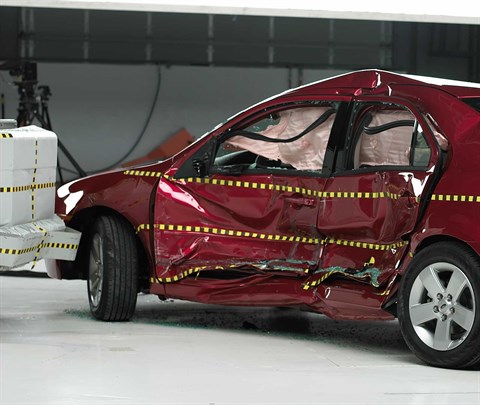
View of the vehicle and barrier just after the crash test.
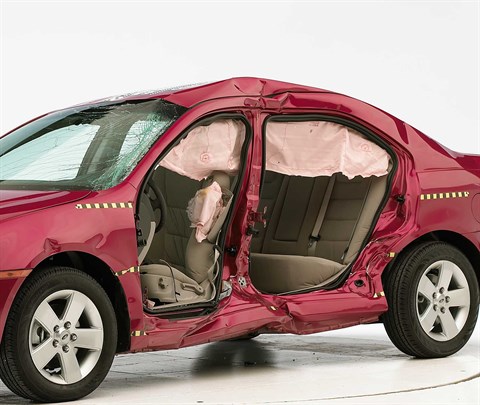
View of the vehicle after the crash with doors removed, showing the side airbags and damage to the occupant compartment.
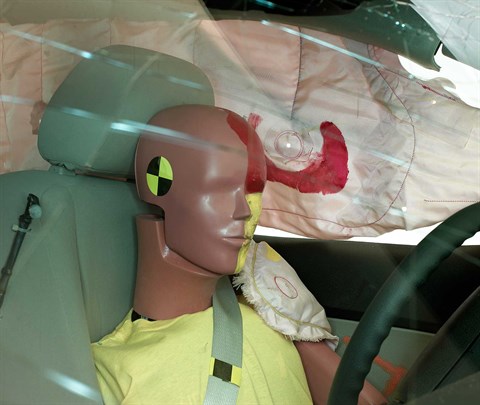
Smeared greasepaint shows where the driver dummy's head was protected from being hit by hard structures by the side airbags.
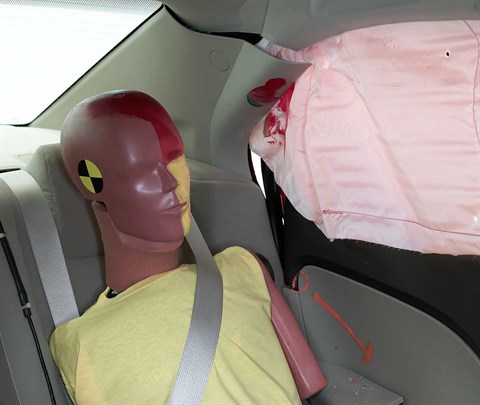
Smeared red greasepaint shows where the rear passenger dummy’s head was protected by the side airbag.
Roof strength
Rating applies to 2006-10 models built before May 2010
Tested vehicle: 2010 Ford Fusion SE 4-door
| Overall evaluation | |
|---|---|
| Curb weight | 3,394 lbs |
| Peak force | 11,300 lbs |
| Strength-to-weight ratio | 3.33 |
Head restraints & seats
Seat type: Manual-power cloth seats
| Overall evaluation | |
|---|---|
| Dynamic rating | |
| Seat/head restraint geometry |
About the head restraint & seat test
Currently, IIHS tests apply only to front seats.